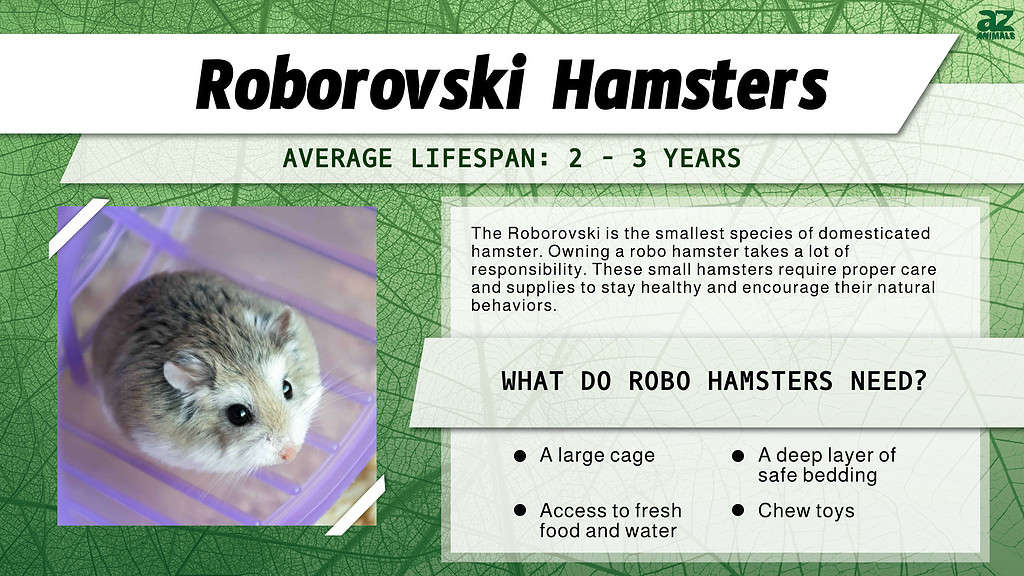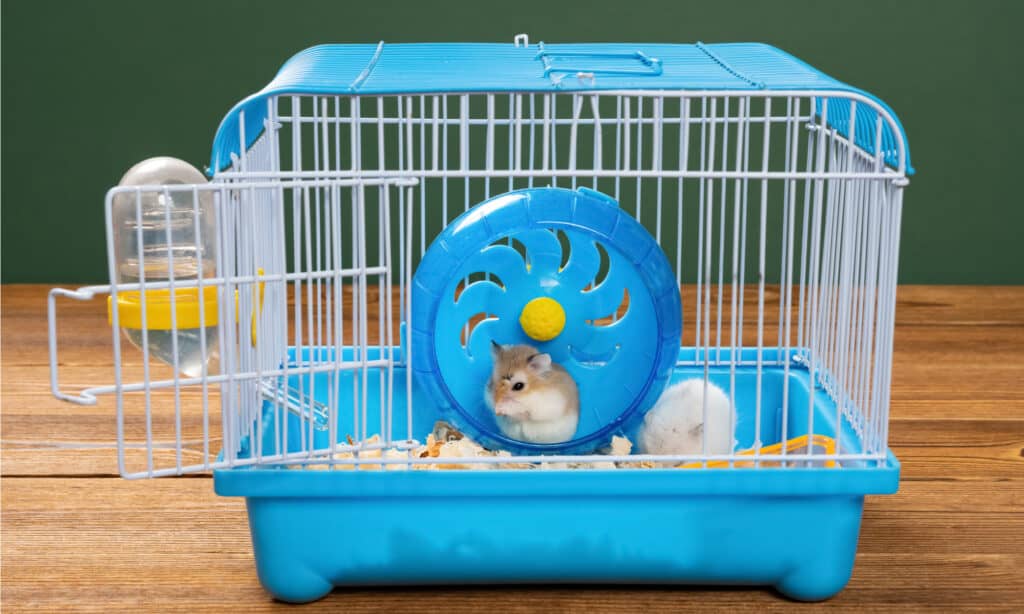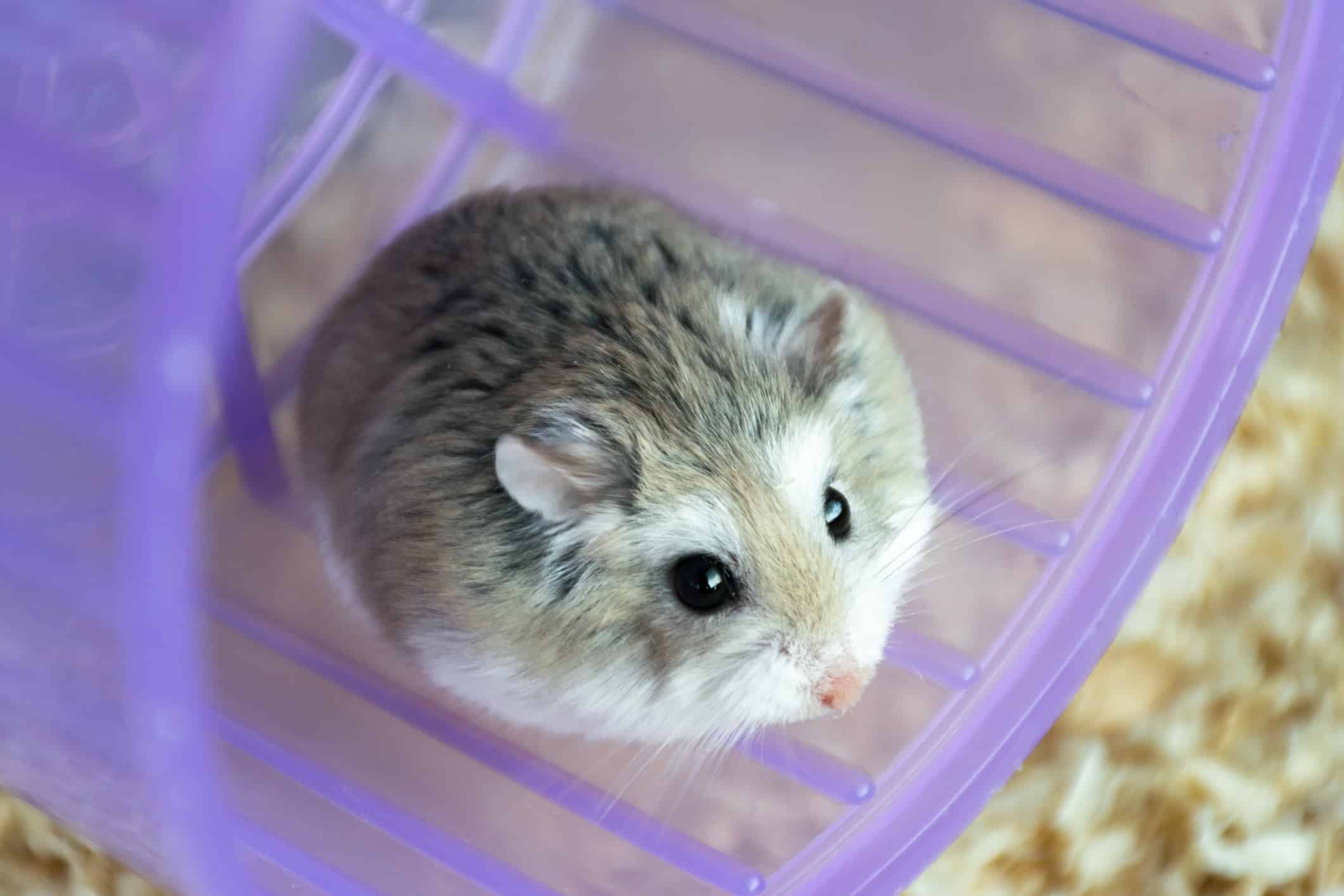The Roborovski, also referred to as a robo dwarf hamster, is a small and active pet that requires specialized care. They are the smallest species of domesticated hamster at around 2-3 inches in size. Robo hamsters are available in an agouti coloration with sandy brown and white bodies and no dorsal stripe. However, robo hamsters can also be found in rarer color forms like mottled, platinum white, red-eyed, and piebald.
At first, robo dwarf hamsters might be a bit shy, but with plenty of socialization and proper care, they can make fun and interactive pets for both adults and children alike.
Lifespan and Care Requirements

Caring for a robo hamster takes a lot of responsibility, time, and finances. Before getting a robo dwarf hamster, you need to ensure that you can meet all of their needs. Like all species of hamster, the robo is a short-lived pet.
Roborovski hamsters have an average lifespan of around two to three years, but certain factors can influence this. A healthy and well-bred robo is more likely to live longer than receiving improper care. Some robo hamsters can live well into their third year, but this is uncommon.
Although robo hamsters do not live for very long, they still require the proper care. They are not disposable pets that can be kept in small wire cages with an improper diet and enrichment. Instead, robo hamsters require a spacious enclosure with a deep layer of substrate for burrowing, a quality diet, medical attention, and plenty of enrichment.
Most of the robo hamster’s care requirements are similar to that of other hamster species like Syrians and dwarves. As the smallest species, the main difference is that they require smaller supplies and less food than other hamsters.
Pet Care Essentials
Let’s take a look below at what a robo hamster’s care entails.

Small, wired cages are commonly sold at pet stores, but they are unsuitable for any species of hamster.
©Freer/Shutterstock.com
Enclosure
Minimum cage size: 39 (L) × 19 (W) × 24 (H) inches
The Roborovski hamster needs a spacious cage that meets the minimum floor space requirements of around 700 to 740 square inches. A large cage with continuous floor space will provide robo hamsters with enough space to live comfortably. Unfortunately, this means that the majority of pet store cages are too small for hamsters. Although those wire cages are marketed towards hamsters and contain brightly colored tunnels and wheels, they are not suitable for any species of hamster.
Robo hamsters are very active and enjoy exploring, so confining them to a small cage isn’t ideal. Even if you plan to take your robo hamster out for daily playtime or give them an exercise wheel, it still won’t replace their need for a large cage.
One mistake new hamster-owners make is choosing the wrong-sized cage for their hamster. This can be a costly mistake since most pet store cages are expensive. Instead of having to spend money on the wrong cage for your robo and having to upgrade it later, purchasing the right-sized cage from the start is best.
You can either have your robo hamster cage custom-made to fit the proper dimensions, or you can consider the alternatives. Large glass fish tanks or plastic bins can be converted to a comfortable enclosure for your robo hamster. You will need to create a mesh lid for these types of cages to prevent your robo from escaping and keep the cage ventilated.
Another option is secure rabbit or guinea pig cages with wire mesh to prevent your robo from escaping from the bars. You can also purchase hamster cages that already meet the minimum size requirements. These cages can be costly, but they are worth the price.
Bedding/Substrate
Robo hamsters are avid burrowers and create deep burrowing systems in the wild. In captivity, this can be difficult for them unless they have a deep layer of bedding in their cage. According to PetMD’s veterinarian, hamsters need at least 6 to 8 inches of bedding. This will encourage your robo hamster to create burrows where they will spend most of their time eating and sleeping. A deep layer of bedding is also a form of enrichment for them.
There are many different bedding options for hamsters, but not all of them are safe. Some substrates that are marketed for hamsters are unsuitable and may even put your hamster’s health at risk.
| Unsafe | Safe |
|---|---|
| Pine and cedar bedding (even kiln-dried) | Unscented paper-based bedding |
| Unlabelled bedding | Aspen wood shavings |
| Printed newspaper | Sterilized play size (not dust) |
| Sawdust | Torn toilet tissue |
| Cat litter | Soft hay and grasses |
| Cotton-fluff nesting material | Coco peat or fiber |
| Scented or medicated bedding | Hemp bedding |
| Corncob | Walnut bedding |
| Straw | Paper-based pellets |
The best bedding for robo hamsters would be unscented paper bedding. This type of bedding is widely available and usually very safe. There are various well-known brands that manufacture paper bedding for hamsters. You ideally want to choose bedding for your robo hamster that is dust extracted, non-toxic, and not harmful when ingested. Robo hamsters also enjoy different bedding textures in the cage, such as a mixture of paper bedding and coco peat.
Keep in mind that not all of the bedding on the suitable list are good for burrowing. Some of them do not hold burrows properly, so they need to be mixed in with bedding that can hold burrows.
Diet

All hamsters need a balanced and healthy diet.
©RaquelVizcaino/Shutterstock.com
Robo hamsters are omnivores and thrive on a diet of pellets, grains, seeds, nuts, and fresh foods. When choosing a hamster food, you want to consider the food’s quality and variety. Although robo hamsters can be fed a pellet food on their own, adding variety to the food encourages their natural foraging behavior. The food you choose for your robo should be high-quality and low in fillers. The pellets will form the basis of your robo hamsters’ diet, and seed mixes can be bought separately.
| Nutrients | Percentage |
|---|---|
| Protein: | 16% – 21% |
| Fiber: | 8% – 12% |
| Fat: | 4% – 7% |
Fresh foods like carrots, spinach, cucumber, and broccoli can be fed to robo hamsters as a treat. They should not be fed often and only in small amounts no more than half a teaspoon in size. Any fresh foods that your robo hamster does not eat should be removed to prevent spoiling.
Like all hamsters, the robo is a hoarder with two cheek pouches on either side of their face. Robo hamsters will naturally store their food in their cheek pouch to bring it back to their nest. This is their preferred place to eat and protect their food stash.
Enrichment
Robo’s can become bored if they do not have any enrichment in their cage. The best forms of enrichment for robo hamsters are exercise wheels, chew toys, deep bedding layers, and sand baths. Hamsters love to chew, so offering them safe and non-toxic chew toys is a great way to encourage this behavior. Their teeth also continuously grow throughout their lives, so chew toys help keep your hamsters’ teeth in good shape.
As an active species of hamster, robo’s love running on their exercise wheel. They need a wheel between 8 to 10 inches in size with a smooth-running surface. You want to avoid wheels with mesh or bars since your robo’s paws can get trapped or damaged by them.
Robo hamsters love to clean themselves in sand since hamsters should never be bathed in water. Instead, the best way to bathe your robo hamster is in sterilized bathing sand for rodents. The sand should be unscented, dust-free, and non-toxic. Robo hamsters benefit from having different interactive toys in their cage as well. This includes things like tunnels, mazes, millet or oat sprays, reptile vines, cork bark, and wood pieces. Levels and ladders are not recommended for robo hamsters since they may fall and injure themselves.
Cost Considerations

Roborovski hamsters need to be taken to an exotic veterinarian when they are sick or injured.
©Pixel-Shot/Shutterstock.com
Although hamsters are not as expensive as dogs or cats, they do have various initial and ongoing costs worth considering. The Roborovski hamster itself only costs between $10 to $30, which is fairly cheap. However, the proper supplies, food, and cages are costly. A robo hamster and their supplies may cost you around $300 to $550 in total. The cage, food, water bowls, and certain enrichment items will be once-off costs.
Although they can be pricey at first, the ongoing costs for a robo hamster are much less. You will only need to spend money on your robo hamsters’ food, bedding, treats, bathing sand, and toys on a monthly basis. This will be around $30 to $60 per month depending on how quickly your robo hamster needs these supplies replaced.
Like most pets, your robo hamster needs to be taken to an exotic veterinarian when they are ill. This means that you will need to spend between $30 to $950 for a vet visit, so be sure that you have set money aside in case your robo does need to see a veterinarian. Some of the medical procedures they need to be done can cost hundreds of dollars which not everyone has the finances for.
Important Facts and Tips

Robo hamsters are fast and small hamsters that can be difficult to handle.
©iStock.com/krblokhin
Handling and Socialization
Roborovski hamsters are often described as being a timid species of hamster. They can take longer to warm up to their owners before they can willingly be handled. Robo’s are also very fast, and their small size makes it difficult to hold them in comparison to other hamsters. While some robo hamsters can become holdable with early handling and socialization, others are too fast and fearful of being held.
When you first get your robo hamster, it is recommended to let them settle into their new home for three to five days. This means that you should leave your robo hamster alone and not interact with them aside from replacing their food and water. After this acclimation period, you can begin taming them.
The taming process involved getting your robo used to your scent and being handled. During this time, you can offer them healthy treats in the palm of your hand. Avoid picking them up right away, since this can stress them out. Some experienced robo owners recommended handling them over a soft blanket or pillow since robo hamsters are fast and may jump out of your hands. It is best to purchase a playpen or sit with them in a dry bathtub to prevent them from escaping during taming.
Keeping Roborovski Hamsters Together
Unlike most hamster species who are solitary, Roborovski hamsters are able to live in same-sex pairs or small groups. However, keeping robo hamsters together takes a lot of responsibility and experience, so it is best left for novice hamster owners.
You do not have to keep your robo hamsters together since they do not get lonely or crave companionship. Another factor to consider when keeping robo hamsters together is that they require a larger cage and more supplies. Keeping two hamsters means upgrading the cage and purchasing more food, exercise wheels, toys, and hideouts. This can double the costs you can expect to spend on your robo hamster both initially and monthly.
Furthermore, robo hamsters may fight when they are kept together. This could result in injuries that require expensive vet visits. If your robo hamsters do fight, you will need to purchase another suitable cage and supplies for them which can be costly.

Hamsters are solitary and shouldn’t live together. However, robo hamsters are sometimes an exception.
©iStock.com/Olga Skred
Tips for Keeping Roborovski Hamsters Healthy
Here are some tips you can use to keep your Roborovski hamster happy and healthy in your care.
- Ensure that your robo hamster has a large cage filled with enrichment items and a deep layer of bedding. If you choose a barred cage for them, you will need to make sure that the bar spacing is too small for them to squeeze through. The robo hamster’s small size makes it easy for them to squeeze through small spaces that other hamsters can’t.
- Robo hamsters require access to fresh water and food daily. Their food bowl should be kept filled and topped up when necessary. Hamsters have very fast metabolisms that require them to eat throughout the day.
- Your robo hamster’s cage should be spot-cleaned two to three times a week and deep-cleaned every one to two months. Spot cleaning involves removing soiled bedding that they urinated on, replacing their bath sand, and removing old food. When you do a deep clean on their cage, you will be removing most of their bedding to replace it with a fresh batch and wipe dirty surfaces of the cage with a non-toxic cleaning solution.
- Our last tip is to perform weekly health checks on your robo hamster. You should check that your robo is in overall good health with tidy fur, bright eyes, and no limping or visible injuries. If you can handle your robo, you should check for any lumps and bumps that could indicate cancer or an abscess. It is also recommended to take your robo hamster for a veterinarian checkup when they reach their senior life stage (over 1.5 years).
Conclusion
Owning a robo hamster can be overwhelming at first, especially since they are difficult to handle. However, they can become quite sociable and lively when cared for properly. If you or your child are planning on getting a robo hamster, it is best to gather all their necessary supplies and large habitat first. This gives you time to prepare your new robo hamsters at home before they are placed inside.
Thank you for reading! Have some feedback for us? Contact the AZ Animals editorial team.








